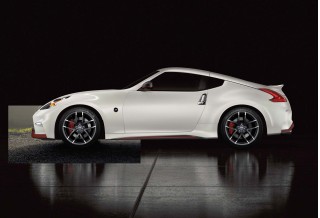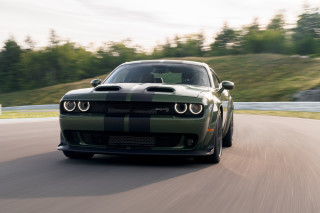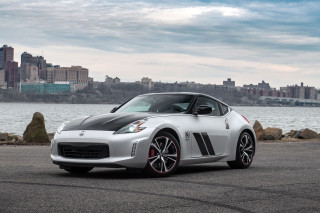Likes
- Unmatched retro swagger
- 707-hp Hellcat flagship
- Surprisingly comfortable ride
- Back seat is more hospitable than rivals
Dislikes
- Safety scores are subpar
- Rear seat hard to access
- V-8s get expensive fast
- Starting to look a little too familiar
Buying tip
features & specs
Charting a decidedly different course than the Mustang and Camaro, the Dodge Challenger is a touring coupe with unmatched bravado.
Few cars wave the American flag with as much bravado as the Dodge Challenger—after all, it wasn't that long ago that Dodge's marketing arm envisioned George Washington behind the wheel of one.
Despite that swagger, in many ways this beast of a tire-burning two-door hasn't kept pace with the smaller, more nimble, and more European-inspired Ford Mustang and Chevrolet Camaro. The Challenger rates a 6.7 overall for its combination of thrills, style, and compromises. (Read more about how we rate cars.)
Changes for 2017 are modest and this big coupe continues to offer SXT, R/T, R/T Shaker, R/T Scat Pack, SRT 392, and SRT Hellcat flavors that range from all show and some go to ferocious. The 2017 SRTs gain new wheels, while nearly all models benefit from infotainment upgrades that include Apple CarPlay and Android Auto connectivity.
A late announcement for 2017 is the new Challenger GT, which features standard all-wheel drive mated to the 8-speed automatic and 3.6-liter V-6 normally reserved for the rear-drive Challenger SXT. The GT is positioned as more of a grand-tourer (hence its name) than a proper muscle car.
2017 Dodge Challenger styling and performance
Even the base Challenger SXT has substantial road presence, operating something more like a grand touring coupe than a track-honed performance car. But if you want to turn up the wick, the R/T and SRT models deliver even more. Exterior styling cues from the 1971 Challenger remain, but the current model's basic look dates back to 2008. A function power bulge Shaker hood is optional on R/Ts for a properly '60s throwback, but things are more modern inside with a fully customizable 7.0-inch instrument panel and an available 8.4-inch infotainment screen.
The standard powertrain in the Challenger SXT remains a 305 horsepower 3.6-liter V-6. Then there's the R/T model's 5.7-liter Hemi V-8, which is rated at up to 375 horsepower and 410 pound-feet of torque. Next, the R/T Scat Pack and SRT 392 utilize a 6.4-liter Hemi V-8 that Dodge rates at a thundering 485 horsepower and 475 pound-feet torque.
At the top of the lineup remains the supercharged 6.2-liter V-8 in the SRT Hellcat that produces a staggering 707 horsepower and 650 pound-feet of torque, making the Hellcat (and its Dodge Charger SRT Hellcat sibling) the most powerful muscle car—and production car from Detroit—ever built.
An 8-speed automatic is available on all Challengers, but V-8 models also offer a 6-speed manual gearbox. Underneath, Challengers ride on a rear-wheel drive platform that dates back nearly two decades, although all-wheel drive is now available.
Suspension tuning varies by model, but even the base model is firm and composed. All models are more composed than their sporting aspirations might suggest, but at upwards of 4,500 pounds once a driver is buckled in for the SRT Hellcat, no Challenger is as lithe as a Mustang. Still, big Brembo brakes and high-tech shocks (Bilsteins with the Super Track Pack or adjustable dampers on the SRT 392 and Hellcat) keep things confident and in check.
2017 Dodge Challenger comfort, safety, and features
The Challenger's hefty footprint pays dividends inside, where it remains the only American muscle coupe to offer seating for five. Access to the back seat requires some contortion, and only two adults will really be comfortable there, but it's doable for short pinches. At 16.2 cubic feet, the trunk is also larger than those of even some mid-size sedans on the market.
Thick roof pillars and a high belt line don't endow the Challenger with good visibility, and even a backup camera is optional. On the safety front, the Challenger feels a little stuck in the past. There's no available automatic emergency braking, and crash test scores from the IIHS and the NHTSA are not especially strong.
You can order a Challenger just about any way you like it, with 10 trim variations and dozens of options on offer. Gone are the days of fully a la carte options like you would have seen on a 1971 Challenger, but a wide variety of colors, wheels, and styling packages help ensure that your Challenger won't look a lot like your neighbor's challenger.
Despite its relative size and potent powertrains, the Challenger can be equipped to manage respectable fuel economy. In V-6 form, the Challenger can return up to 30 mpg highway, and much of the lineup can manage up to 25 mpg.
2017 Dodge Challenger Styling
Some things never get old. The Dodge Challenger was a classic the minute it burnt its first rubber.
Nothing about the 2017 Dodge Challenger is subtle in any form or fashion. Its huge haunches and wide rubber were designed for a purpose—to go fast while attracting a lot of attention.
We can't argue with this recipe; although it lacks the grace of the Chevrolet Camaro and Ford Mustang (and that's something we never thought we'd say), there's something undeniably great about the Challenger, which earns it a 8 out of 10 for styling. (Read more about how we rate cars.)
That look has been updated since 2008, when the current Challenger launched, but there's no denying that the basic shape has remained unchanged outside. For 2017, SRT Hellcats get new alloy wheels.
Inside, the Challenger got a boost a few years ago that gave it a more modern design with a high-tech 7.0-inch customizable instrument cluster TFT screen. An optional 8.4-inch touchscreen in the dashboard provides a home for an updated-for-2017 infotainment system with a higher resolution screen and better functionality.
Like the '71 Challenger that inspired it, the current model's center console rises up on the passenger side and throwback-style houndstooth cloth trim (optional on SXT and R/T trim levels) is available for the seats (not to worry, premium leather and Alcantara synthetic suede materials are also available). SRT models also gain new illumination for the center of their steering wheels—a white LED SRT logo for Hellcats and a red one for 392s.
2017 Dodge Challenger Performance
Even the V-6 Challenger is quick, but the V-8s do the modern muscle car thing especially well.
Though the Dodge Challenger certainly lacks the track day zip of the Ford Mustang and Chevrolet Camaro, this coupe's more relaxed grand touring feel and wide range of engines still offers something for just about everyone.
After all, muscle cars never were about going around corners—but the Challenger does that fairly well, too, which is why we rate it an 8 for performance. (Read more about how we rate cars.)
At the base level, Challenger SXT and SXT Plus models utilize a 3.6-liter V-6 that makes 305 horsepower and 268 pound-feet of torque. It's solely offered with an 8-speed automatic transmission, a combination that offers up both enough off-the-line pep to feel like a muscle car and sufficient high-revving passing power to never feel short on steam.
Even though the V-6 Challenger is faster than most muscle cars ever were, it still feels a little neutered up against the V-8s. Opt for the R/T and you get a 5.7-liter V-8 making 375 hp and 410 lb-ft of torque with a 6-speed manual. (R/T models with the optional 8-speed automatic come in at 372 hp and 400 lb-ft.)
The newly minted Challenger GT comes with all-wheel drive and a V-6 that adds a level of confidence in cold weather states for buyers interested in muscle, but also avoiding a snowy ditch. The system disconnects the driveline unless power is needed at the front and it's all very seamless. Throw the GT into sportier modes and the front wheels never get power, no matter how sideways you get. The penalty is obviously in the weight added for the AWD running gear (just over 200 lbs.) but it's negligible.
Above that sits the R/T Scat Pack and the SRT 392, which have a higher-output 6.4-liter "Apache" version of the V-8 that makes 485 horsepower and 475 pound-feet of torque. Again, a 6-speed stick is standard and an 8-speed automatic is optional. No matter how you slice it, the 6.4-liter V-8 is more than adequate for scaring just about anyone at a stop light.
But if it's domination you're after, the 707-horsepower SRT Hellcat is your only choice.
The Hellcat is fitted with a supercharged 6.2-liter V-8 that will run through a quarter-mile in 11.2 seconds at 125 mph before topping out at nearly 200 mph. That’s on the optional Pirelli P Zero performance tires, which have loads of grip but are predictably atrocious in winter. When fitted with full-on drag radials, the Hellcat will do a 10.8-second run at 126 mph. Those figures are with the optional 8-speed automatic, which suits this powertrain beautifully—although a 6-speed manual is on offer here as well.
The Hellcat is very easy to drive for a car with so much power under its hood, with a ride that is only marginally firmer than a standard Challenger in the adaptive suspension's "Normal" mode. No Challenger is really a track star compared to the Mustang and Camaro, but all variants have strong brakes well matched to the power under their hoods and accurate power steering (which is hydraulic in the Hellcat). That last point is an especially salient one, as although the power steering on the standard Challengers is nicely weighted, it lacks the road feel that's more evident in the Hellcat.
Regardless of Challenger flavor, all are pleasantly composed, with the SXT and R/T providing an almost luxurious ride quality (thanks in part to their taller sidewalls). The Hellcat offers more tenacious grip but its girth—around 4,500 pounds—prevents it from feeling even remotely delicate.
But if it's tire-shredding power you're after, the Challenger might surprise you with its twisty road composure.
2017 Dodge Challenger Comfort & Quality
Given its big footprint, you'd think the Dodge Challenger would offer more interior space.
Big upgrades over the last few years mean that the Challenger feels almost like a personal luxury coupe inside, especially with a few options piled on. They're all quiet and refined, but as with any coupe, passenger space is a major compromise.
Because of that, we rate the Dodge Challenger 6 for its comfort and quality. (Read more about how we rate cars.)
A new dashboard a couple of years ago carries over largely unchanged and it benefits from nice material upgrades. Acoustic glass and substantial sound deadening, which helps account for the Challenger's curb weight, quells even the most performance-oriented tire options. There's some engine noise, especially with the V-8, but that's what owners generally want in a showy coupe like this.
The Challenger's front thrones almost feel like they were plucked from a proper luxury car, and the finer grade leather offered as an option on higher trim levels reinforces that notion. While the driver and front passenger will be comfortable, rear seat riders certainly take a back seat. Once back there, there's decent head and foot room for two, but not as much as the Challenger's exterior dimensions would suggest.
Trunk space is absolutely huge. With 16.2 cubic feet of space, the Challenger has the trunk of a large sedan. While it is shallow, the space is wide and long, and can accommodate several large suitcases. Who would have expected a muscle car to be a good road trip companion?
2017 Dodge Challenger Safety
The Challenger lags in crash tests and available safety equipment.
The 2017 Dodge Challenger comes up short on standard and available safety technologies and it doesn't perform all that well in every government and insurance industry crash test, which is why it scores just 5 out of 10 for safety. (Read more about how we rate cars.)
The Challenger lacks as standard a rearview camera and there is no automatic emergency braking option. You can order adaptive cruise control and a forward-collision warning system, as well as blind-spot monitors with rear cross-traffic alerts, however.
The federal government says that the Challenger scores a solid five stars overall, although it merits just four stars for frontal collision and rollover.
The IIHS, which is funded by the insurance industry, isn't quite as complimentary. The Challenger does score the top "Good" ratings for moderate overlap front and side impacts, but it scores a far less impressive "Marginal" for the more challenging small-overlap frontal collision test, where the passenger safety cell was not well maintained.
Additionally, the IIHS awarded the Challenger with just "Acceptable" for the strength of its roof and for its seat head restraints.
2017 Dodge Challenger Features
Dodge will build you a Challenger in just about any flavor (or color) you could ever want.
So long as you don't want a convertible, Dodge has a Challenger for every taste and every budget, it seems.
The lineup includes four core nameplates, plus a host of trim packages: SXT, R/T, SRT 392, and SRT Hellcat. Because of this wide range of available features, and a decent standard setup, the Challenger scores a 7. (Read more about how we rate cars.)
The breakdown
SXT refers to the 3.6-liter V-6, but even the base model is nicely outfitted with dual-zone automatic climate control, a 7.0-inch TFT instrument panel display screen, a 5.0-inch infotainment system, Bluetooth, a power driver's seat, an auto-dimming rearview mirror, a leather-wrapped steering wheel and shift knob, automatic headlights, and 18-inch aluminum wheels. The SXT Plus adds way more—nappa leather trim, 20-inch alloy wheels, a rearview camera, a heated steering wheel, air conditioned seats, an Alpine audio system, and an updated-for-2017 8.4-inch infotainment system.
That infotainment setup benefits from what Dodge says is more responsive software and a nicer screen with pinch and scroll ability for the available navigation system.
R/T models get bigger brakes, a decklid spoiler, and an available "shaker" hood—a cutout that reveals the visibly shaking 5.7-liter V-8 engine.
SXT and R/T models can be ordered with a Blacktop Appearance package that was new last year. On the outside, it includes 20-inch five-spoke gloss black aluminum wheels, a gloss black grille, satin black finishes on the deck-lid spoiler and fuel-filler door, a “strobe” designed dual stripe, and fog lamps. Inside, this package adds a performance steering wheel with paddle shifters and dark finishes, and a choice of black cloth upholstery or perforated nappa leather in SXT Plus and R/T Plus models.
A Super Track Pak package adds a performance-tuned suspension and upgraded brakes, as wells unique steering tuning and Goodyear Eagle F1 performance tires. Try before buying, but enthusiastic drivers should look to tick this box.
Especially of interest to enthusiasts with more budget (and tires) to burn is the Challenger R/T Scat Pack. It's basically a cheap way to get into the SRT-tuned 6.4-liter V-8, but the Scat Pack also includes Brembo four-piston brakes, a large aero front splitter, its own suspension tuning, and apps that let a driver track his or her 0-60 sprint time and g-forces, for instance.
The SRT 392 uses the same V-8 and includes a host of styling touches, even better Brembo brakes with six-piston calipers, an adjustable adaptive suspension, and unique seats. If the 6.4-liter V-8 isn't music to your ears, a 900-watt Harman Kardon audio system also comes on the SRT 392.
In the unlikely event that an SRT 392 isn't enough, Dodge will be happy to sell you 707 horsepower worth of SRT Hellcat. The supercharged model gains new badging inside and out, a steering wheel with an illuminated center cap (which is red here and white on the SRT 392), and new-for-2017 alloy wheels that weigh 4 pounds less at each corner compared to last year.
2017 Dodge Challenger Fuel Economy
No V-8 Challenger is a miser, but the V-6's 30 mpg highway isn't bad.
If you're interested in a V-8 muscle coupe, fuel economy probably isn't on your mind. But the V-6 is remarkably thrifty, coming in just a tick lower than the much fresher Ford Mustang and Chevrolet Camaro.
You'll see 19 mpg city, 30 highway, 23 combined on a V-6 with its standard 8-speed automatic, Dodge says, which helps the Challenger score a 6 for its greenness. (Read more about how we rate cars.)
Opt for a V-8 and things other than rear tire rubber deteriorate. An R/T with the automatic comes in at 16/25/19 mpg, while the 6-speed manual drops those figures to 15/23/18 mpg.
R/T Scat Pack and SRT 392s come in even lower: 15/25/18 mpg for the automatic, and 14/23/17 mpg for the stick.
We don't expect 707 horsepower to result in anything other than fuel guzzling, but the SRT Hellcat doesn't force as big of a penalty as you might expect. You'll see 16 mpg combined regardless of transmission, according to the EPA's test.












































































































